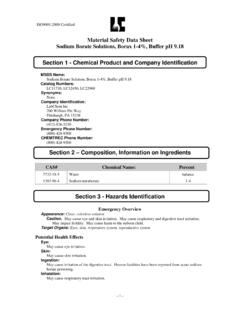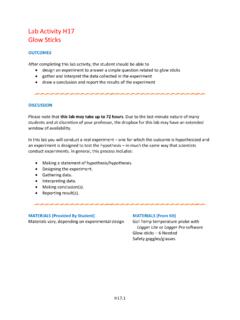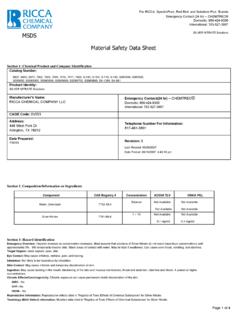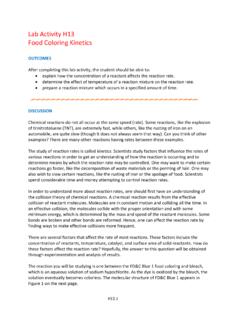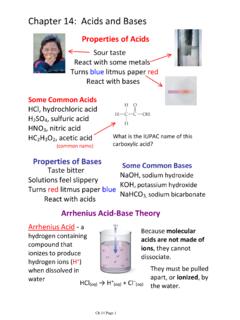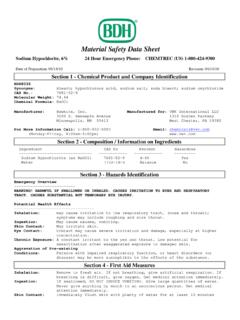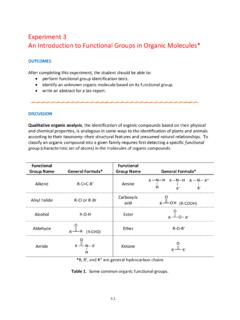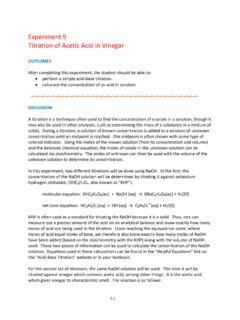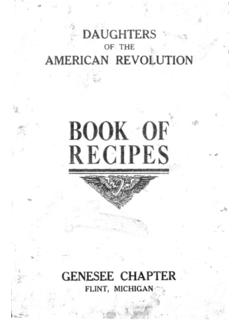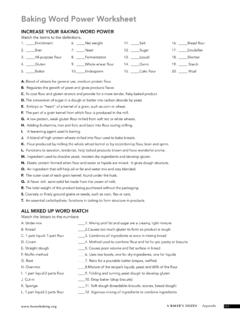Transcription of Lab Activity H12 The Baking Soda Volcano Reaction
1 Lab Activity H12 The Baking soda Volcano Reaction OUTCOMES After completing this lab Activity , the student should be able to: find the actual, theoretical, and percentage yields for a given Reaction . explain the concept of limiting reactant. DISCUSSION Many of you have likely seen or performed a Reaction between Baking soda and vinegar before. Frequently referred to as a Volcano Reaction , since large amounts of gas are produced when the two materials are quickly mixed together in large proportions, the chemical Reaction between Baking soda and vinegar is the Reaction many kids first see or remember in their elementary school science experience.
2 Sodium bicarbonate, the chemical name for Baking soda , is used as a leavening agent in many recipes. A leavening agent is a substance that causes a dough or batter to rise, giving it more volume and a lighter or fluffier texture. Baking soda does this by releasing bubbles of carbon dioxide gas that get trapped in the dough or batter caused simply by heating in an oven or deep fryer, and often enhanced by adding a slightly acidic ingredient (such as vinegar or buttermilk) that reacts with the Baking soda to produce the bubbles. Baking soda is a very environmentally friendly chemical that has many other uses.
3 While an internet search will undoubtedly turn up many other uses for Baking soda , here are some of the other ways the author has used Baking soda : Scrubbing toilets, bathtubs, and showers, especially to remove soap scum. Placing an open box in the refrigerator to remove odors. Filling and emptying stinky shoes to freshen them up. Adding to loads of laundry to remove musty smells from towels or other items. Removing corrosion from car battery terminals by dipping a damp toothbrush into Baking soda and scrubbing. Throwing a box into a wood stove to extinguish a chimney fire, since heating Baking soda releases carbon dioxide found in many fire extinguishers.
4 Removing baked on grease and splatters that form around stove top burners. When heated, Baking soda becomes more basic making it effective for this purpose. Consuming a small amount dissolved in a glass of water see Baking soda box for directions though one must remain upright to burp out the carbon dioxide gas generated when ingested to avoid a large buildup of gas in the stomach. Acetic acid (IUPAC name ethanoic acid) is the acid found in vinegar. Acetic acid may be produced through the oxidation of ethanol found in wine, beer, or fermented fruit juice. For this reason, limiting the exposure of wine to air prevents it from taking on the taste of vinegar.
5 Vinegar is also an environmentally friendly chemical with many uses. Uses by the author include lowering the pH of soil for various growing applications, cleaning lime deposits around faucets and shower heads, cleaning toilets, soaking glassware to remove dull film and restore luster, and running through an empty dishwasher to remove caked on soap and scraps of food. Once again, an internet search will turn up many other uses. The balanced chemical equation for the Reaction between Baking soda and vinegar is: NaHCO3 (s) + HC2H3O2 (aq) NaC2H3O2 (aq) + H2O (l) + CO2 (g) In this lab, the combined mass of Baking soda and vinegar will be measured before and after reacting them together.
6 The difference in the two masses will yield the mass of carbon dioxide produced in the Reaction . The actual mass of carbon dioxide measured in this experiment should be less than the theoretical mass of carbon dioxide calculated, due to the solubility of carbon dioxide in water ( g/L at 20 C). MATERIALS (Provided By Student) MATERIALS (From Kit) Baking soda (not Baking powder) Beral pipet Spoon Electronic Balance White Vinegar (5%) - 1000 mL (1 L needed) Graduated cylinder - 100 mL Plastic cup Portion cup, translucent Safety Goggles/Safety Glasses REQUIRED PHOTO: Includes your face and/or clearly shows a Picture (with name), with all of the materials used in this lab visible.
7 PROCEDURE EYE PROTECTION MUST BE WORN AT ALL TIMES DURING THIS EXPERIMENT! 1. Turn on and tare the electronic balance. Place an empty plastic cup onto the electronic balance. Measure and record the mass into column (A) of the data table. 2. To avoid damaging the balance, remove the cup from the balance. Use a graduated cylinder to add 75 mL of vinegar to the plastic cup. Place the cup back onto the balance. Use a dropper to add or remove vinegar to bring the mass of vinegar in the cup to exactly g, taking into consideration the mass of the cup. Record the combined mass of the cup and vinegar into column (C) of the data table.
8 Example: If the cup has a mass of g, then exactly g of vinegar added to the cup would bring the combined mass of the cup and vinegar to g. 3. Remove the cup containing the vinegar and place a portion cup onto the balance. Measure and record the mass of the portion cup into column (D) of the data table. 4. Using a spoon, add the exact mass of Baking soda shown in column (E) of the data table to the portion cup for the respective trial, remembering to take into consideration the mass of the cup. Record the combined mass of the portion cup and Baking soda into column (F) of the data table.
9 5. Sum together the masses found in columns (C) and (F) to find the combined mass of both cups and both reactants before the chemical Reaction . Record the sum into column (G) of the data table. 6. Remove the portion cup from the balance. Without spilling, slowly pour the Baking soda into the cup containing the vinegar in small portions. As the Baking soda is added, gas bubbles will form and the mixture will begin to foam up. Do not allow the foam to rise higher than to the height of the cup to prevent loss of any liquid. Before adding additional portions of Baking soda , it is best to allow the foam to settle and disappear.
10 Otherwise, the Baking soda may rest on the surface of the foam and fall into the vinegar at once causing the mixture to foam over. 7. Once the Reaction is complete, allow a few minutes for most of the bubbling to cease. Without emptying the contents of the cup holding the Reaction mixture, place both of the cups onto the balance. If necessary, the portion cup may rest on its edge or be lowered into the larger plastic cup. Record the combined mass of the cups and contents into column (H). REQUIRED PHOTO: Includes the date clearly shown on a calendar, newspaper, cell phone, or written on a sheet of paper, with both cups on the balance and the mass displayed on the balance visible in the photo.
